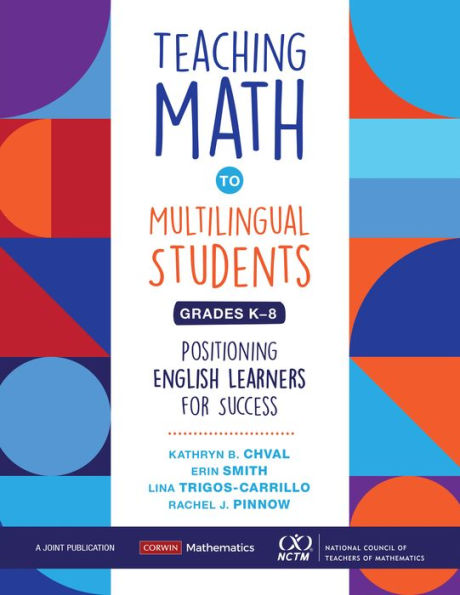Table of Contents
Preface xv
Acknowledgments xix
About the Authors xxi
1 Our Hope for Multilingual Learners
Teachers Who inspire 2
Studying Teacher Practice 4
Interacting With Multilingual Learners and Their Families 7
2 Position Multilingual Learners as Classroom Leaders
Vignette: Xiao Li 10
Vignette: Nabil Abadi 10
Vignette: José López 11
What the Research Says About Positioning 11
Reflecting on Xiao Li's Experience 13
Reflecting on Nabil Abadi's Experience 14
Reflecting on José López's Experience 15
Positioning Students as Experts 16
Reflecting on Why Positioning Matters 20
Recognizing How Teachers Position Students 21
Positioning Multilingual Learners as Leaders 22
Strategies for Positioning Multilingual Learners as Leaders 26
Thinking About Positioning in Your Practice 26
3 Facilitate Multilingual Learners' Participation in Mathematics
Reflecting on Your Experiences With Participation 30
What the Research Says About Student Participation 31
Factors That influence the Participation of Muitilingual Learners 32
Examining Teaching Strategies That Influence Participation 36
Strategies for Facilitating Multilingual Learners' Participation in Mathematics 39
Thinking About Participation in Your Practice 42
4 Facilitate Partnerships Between Multilingual Learners and Their Peers
Solving a Mathematics Problem With a Partner 45
What the Research Says About Peer-to-Peer interactions With Multilingual Learners 46
Qualities of Partnerships 46
Strategies for Facilitating Partnerships 48
Thinking About Partnerships in Your Practice 57
5 Engage Multilingual Learners Through Culturally Relevant Contexts
Reflecting on the Challenge of Contexts and Culture 60
What the Research Says About Contexts in Mathematics 63
Strategies for Engaging Multilingual Learners Through Culturally Relevant Contexts 63
Thinking About Contexts in Your Practice 69
6 Reach Multilingual Learners With Visuals and Gestures
What the Research Says About Visuals and Gestures 72
Using Visuals Strategically 73
Reflecting on Your Use of Gestures 78
Using Gestures Strategically 78
Thinking About Visuals and Gestures in Your Practice 82
Strategies for Using Visuals and Gestures 83
7 Analyze Mathematical Work of Multilingual Learners
Reflecting on Your Experiences 86
What the Research Says About Analyzing Multilingual Learners' Mathematical Work 86
Examining Joaquin's Mathematical Work 87
Analyzing Additional Student Work 90
Strategies for Discerning Between Mathematical and Language Issues 93
Examining Abigail's Work 94
Examining Janessa's work 97
The Importance of Interviewing Multilingual Learners 99
Thinking About Analyzing Multilingual Learners' Mathematical Work in Your Practice 100
8 Investigate Meanings to Enhance Multilingual Learners' Language Development
The Importance of Academic Language for Multilingual Learners 103
What the Research Says About Academic Language 103
Distinguishing Between Multiple Meanings of Language 104
Introducing Specialized Mathematics Language 107
Amplified Use of Academic Language 115
Strategies for Enhancing Multilingual Learners' Language Development 118
Thinking About Academic Language in Your Practice 119
9 Use Your Discourse Strategically to Enhance Multilingual Learners' Opportunities to Learn
Reflecting on Varieties of English That influence Discourse 123
What the Research Says About Discourse 124
Teacher Discourse 125
Strategies for Promoting Classroom Discourse 135
Thinking About Your Discourse in Your Practice 136
10 Foster a Culture of Writing in the Mathematics Classroom
Reflecting on Your Experiences 138
What the Research Says About Writing in Mathematics 139
Establishing a Need to Write in Mathematics 139
Establishing a Culture of Writing 142
Analyzing Students' Mathematical Writing 147
Strategies for Fostering a Culture of Writing in Your Mathematics Classroom 152
Reflecting on Mathematical Writing in Your Practice 153
11 Develop Writing in Mathematics for Multilingual Learners
Reflecting on Your Practice 155
Mathematical Genres of Writing 155
What the Research Says About Mathematical Genres 156
Analyzing Students' Mathematical Writing 157
Identifying Mathematical Writing Genres 162
Strategies for Developing Writing in Mathematics for Multilingual Learners 164
Reflecting on Your Use of Mathematical Genres in Your Practice 166
12 Enhance Curriculum Materials for Multilingua Learners
Reflecting on Mathematics Curriculum 169
What the Research Says About Curriculum Enhancement for Multilingual Learners 170
Analyzing Curriculum Materials for Multilingual Learners 172
Research Recommendations for Enacting Mathematics Curriculum 173
Recognizing Different Mathematical Conventions and Representations 174
Thinking About Mathematical conventions and Representations in Your Practice 176
Thinking About Curriculum Enhancement in Your Practice 177
13 Engage With Parents and Families of Multilingual Learners
Reflecting on Your Experiences 180
What the Research Says About Multilingual Parent and Family Engagement 180
Multicultural Parenting Styles 181
Reframing Multilingual Parental Engagement 192
Strategies for Facilitating Multilingual Family and Parent Engagement in Your Classroom 192
Reflecting on Family Engagement in Your Practice 195
Appendix A Recommended Resources 196
Appendix B Selected Solutions 199
References 201
Index 218



